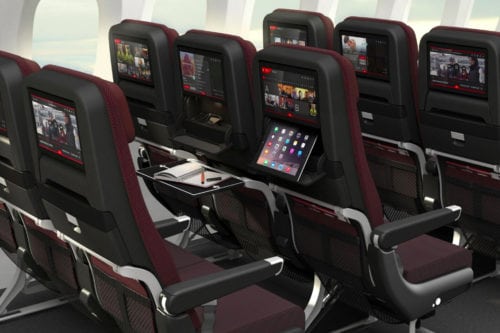
Qantas Boeing 787 economy class cabin. Photo courtesy of Qantas
Six in 10 airlines plan to invest in the Internet of Things (IoT), while nine in 10 intend to invest in major cybersecurity programs or pilot trials over the next three years, according to the latest findings from SITA's 2017 Air Transport IT Trends Insights study.
First released in 1999, the survey offers the air transport industry the latest facts, figures and trends related to technology adoption and IT spending. Respondents range from the world's top 200 airlines to low-cost operators and carriers serving important players in the regional and leisure aviation sectors.
"The survey is truly representative, including the views and insights of carriers representing 41% of global passenger traffic," said Dominique El Bez, Sitaonair's VP of strategy.
While the study does not delve into specific areas of IT investment at the hardware or software level, it does show key trends in how technology will enable airlines' vision for the connected aircraft.
For one, IT spending is increasing. As a percentage of revenue, IT dollars have gone up in 2016 compared with 2015, said El Bez. "Key investment priorities include cybersecurity, cloud services and business intelligence," with cybersecurity emerging as a top priority, El Bez noted. "Airlines also are embracing new technologies and turning to artificial intelligence (AI) to support their customer service."
In fact, over the next three years, 52% of airlines plan major AI programs or R&D.
More than 90% of airlines will ramp up their wireless services for cabin crew and pilots. Compared to the 2016 survey, wireless investment is up 18%. In addition, 60% of airlines plan to or have already implemented high-speed Wi-Fi, with a timeline to complete those rollouts by 2020.
More IoT Initiatives on the Horizon
The survey also reported that 67% of airlines plan to invest in IoT initiatives. That didn't come as a surprise to El Bez.
"A lot of this comes down to airlines meeting passenger demands for seamless in-flight connectivity, regardless of whether this this is explicitly termed IoT," he said. "With 50 to 100 billion IoT devices expected to be in circulation by 2020, from smart watches and other wearables to thermostats, many airlines will continue investment in IFC to connect these devices in the air."
El Bez is quick to say that this is only the beginning, with airlines already investing a wide range of IoT initiatives, including:
- Beacons/sensors to provide proximity-based notifications, wayfinding or retail offers
- Onboard operational services such as fuel/engine monitoring, managing the aircraft environment or managing equipment condition/levels of consumables
- Passenger services such as robotic baggage porters, customer service robots and smart baggage tagging
A significant portion of operators also said they want to further invest in mobile technologies for passengers and crew. Some 87% of surveyed carriers in 2017 compared with 75% in 2016 have implemented or plan to implement mobile service to enhance customer relationship management in the next three years.
Benefits of a Connected Aircraft
Enhancing the passenger experience is a key driver in these investments, while the second most-cited benefit was operationally related, such as maintenance and aircraft health monitoring.
Harnessing the power of aircraft data will continue to be a key driver in IT investments by airlines, but challenges remain, said El Bez.
Today's modern aircraft such as the A380 collects 200,000 bits of information on every flight, but there are significant barriers to using all this data effectively, according to Sitaonair.
For one, many airlines still collect aircraft post-flight and health data manually, which can often can lead to "delays of hours" and "opens up the possibility for errors in the collection process, inefficient data mining and a lack of quantifiable metrics," El Bez said. "Added to this challenge is the fact that airlines often take a siloed approach to data systems, investment and purchasing, with cabin, cockpit and maintenance investment made in isolation."
Airlines are aware of these challenges and are actively pursuing solutions enabled by technology. "The airline industry recognizes that real opportunities are possible by developing intelligent aircraft data systems," El Bez said. "SITAONAIR believes that our open platforms approach, as detailed earlier this year in our hot topic whitepaper, is the way to solve the airline industry's big aircraft data challenge."
He points to Sitaonair's newly launched e-Aircraft DataCapture as an example of "how clever, automated solutions can empower airlines to get a handle on their big aircraft data."
One thing is clear: the industry's connected aircraft vision is here to stay.
